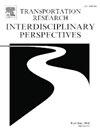Understanding wildfire evacuees’ perceived safety on their evacuation route: A study of the 2018 Camp Fire
IF 3.9
Q2 TRANSPORTATION
Transportation Research Interdisciplinary Perspectives
Pub Date : 2025-03-20
DOI:10.1016/j.trip.2025.101392
引用次数: 0
Abstract
Wildfire evacuations are expected to increase, including evacuations from fast-moving wildfires. Risk perception is an important element that determines evacuee decision-making. However, research has not looked at perceptions of safety while evacuees are on their evacuation route. This study addresses safety perceptions while evacuating, and specifically asks what personal, built environment, and evacuation factors contribute to feelings of safety during a wildfire evacuation? Using post-disaster survey data from the 2018 Camp Fire evacuation, we build an ordered logit model which estimates perceived safety as the outcome, accounting for several factors including evacuee proximity to the oncoming wildfire, socio-demographics, evacuation decision-making, and traffic conditions. The results show that later departure timing, shorter travel time, and pre-planning for evacuation routes and destinations to be associated with increased safety while on the evacuation route. These findings have important implications for emergency planning for wildfires, including fast-moving wildfires as well as evacuation modeling for these events. This research is a valuable first step in understanding perceived safety of evacuees while on their evacuation route and modeling evacuee decision-making while on their evacuation route.
求助全文
约1分钟内获得全文
求助全文
来源期刊

Transportation Research Interdisciplinary Perspectives
Engineering-Automotive Engineering
CiteScore
12.90
自引率
0.00%
发文量
185
审稿时长
22 weeks
 求助内容:
求助内容: 应助结果提醒方式:
应助结果提醒方式:


